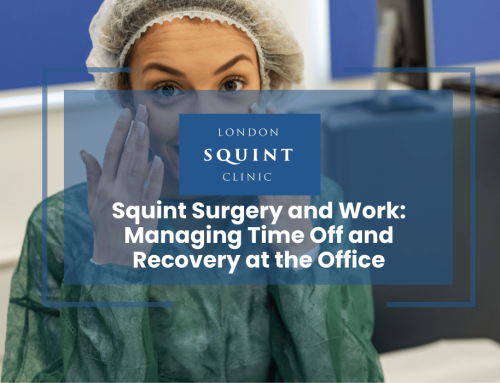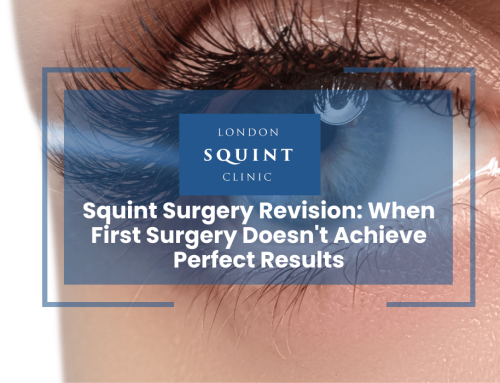Aberrant Regeneration: Misdirected Nerve Healing After Palsy
Essential Insights: Understanding and Managing Aberrant Nerve Regeneration
- Aberrant regeneration occurs when damaged nerves heal incorrectly, creating unusual connections between different functions, particularly affecting the oculomotor (third) and facial (seventh) cranial nerves.
- Common symptoms include pseudo-Graefe sign (eyelid elevation when looking down), crocodile tears syndrome (tearing when eating), and various synkinetic movements where unintended movements occur simultaneously with intended ones.
- This condition most commonly results from trauma, compression, or inflammation rather than ischemic events, with symptoms typically appearing 2-3 months after the initial injury.
- Diagnosis requires thorough clinical evaluation by a neuro-ophthalmologist, including detailed history, ocular motility examination, and specific tests to identify characteristic patterns.
- Treatment options include non-surgical approaches (prism glasses, botulinum toxin injections) and surgical interventions (strabismus surgery, lid surgery) for more severe cases.
- Patients should seek specialist care immediately for sudden vision changes, severe headaches, or progressive symptoms, as these may indicate underlying conditions requiring urgent attention.
Table of Contents
- Understanding Aberrant Regeneration in Cranial Nerves
- The Science Behind Misdirected Nerve Healing
- Common Symptoms of Aberrant Regeneration in Eyes
- What Causes Synkinetic Eye Movements After Palsy?
- Diagnosing Aberrant Regeneration: Clinical Evaluation
- Treatment Options for Misdirected Nerve Healing
- Living With Crocodile Tears Syndrome and Management
- When to Seek Specialist Care for Nerve Regeneration Issues
Understanding Aberrant Regeneration in Cranial Nerves
Aberrant regeneration is a fascinating yet challenging neurological phenomenon that occurs when damaged nerves attempt to heal but reconnect incorrectly. In ophthalmology, this condition most commonly affects the cranial nerves responsible for eye movement and facial expressions, particularly the oculomotor (third) nerve and the facial (seventh) nerve.
When these nerves are damaged through trauma, compression, or inflammation, the body naturally attempts to repair them. However, during this regeneration process, nerve fibres can become misdirected, connecting to muscles or glands they weren’t originally meant to innervate. This creates unusual and often troubling connections between different functions.
For instance, in third nerve palsy with aberrant regeneration, a patient attempting to look upward might experience involuntary eyelid elevation, or when trying to look inward, the pupil might constrict inappropriately. These unusual connections create what specialists call “synkinetic movements” – unintended movements that occur simultaneously with intended ones.
Understanding aberrant regeneration is crucial for both patients experiencing these symptoms and the specialists treating them, as the condition can significantly impact quality of life and requires specialised management approaches that differ from standard nerve injury treatments.
The Science Behind Misdirected Nerve Healing
The process of nerve regeneration is remarkably complex. When a nerve is damaged, the distal portion (away from the brain) degenerates in a process called Wallerian degeneration. The proximal segment (closer to the brain) then attempts to regrow and reconnect with its original targets. In normal healing, these regenerating axons follow their original pathways to reconnect with the correct structures.
However, in aberrant regeneration, these growing axons become misdirected. Several factors contribute to this phenomenon:
- Scar tissue formation: After nerve injury, scar tissue can form, creating physical barriers that divert regenerating axons from their intended paths.
- Loss of guidance cues: Molecular signals that normally guide axons to their correct destinations may be disrupted after injury.
- Competitive reinnervation: Multiple axons may compete to connect with denervated structures, resulting in inappropriate connections.
In the case of oculomotor nerve aberrant regeneration, axons originally destined for certain eye muscles may instead connect to the pupillary sphincter or levator palpebrae superioris (eyelid muscle). This creates unusual functional connections where, for example, attempting to move the eye in a certain direction might trigger pupil constriction or eyelid movement.
The severity of aberrant regeneration depends on several factors, including the extent of the original nerve damage, the patient’s age, and the time elapsed since injury. Younger patients typically demonstrate greater neural plasticity and may show more pronounced aberrant connections as their nervous systems attempt vigorous but sometimes misdirected healing.
Common Symptoms of Aberrant Regeneration in Eyes
Aberrant regeneration affecting the eyes produces a distinctive set of symptoms that can be both functionally limiting and cosmetically concerning for patients. These symptoms vary depending on which cranial nerve is affected and the extent of misdirected healing.
When the oculomotor (third) nerve is involved, patients may experience:
- Pseudo-Graefe sign: Elevation of the upper eyelid when the eye looks down or inward
- Pseudo-Argyll Robertson pupil: Pupil constriction when the eye attempts to adduct (move inward) rather than in response to light
- Limited eye movement: Restricted movement in directions controlled by the affected nerve
- Lid-gaze dyskinesia: Inappropriate eyelid movements when attempting certain eye movements
- Retraction of the upper eyelid: The eyelid appears pulled back, creating an appearance of staring
When the facial nerve is affected, as in cases following Bell’s palsy, symptoms may include:
- Crocodile tears syndrome: Tearing when eating (gustatory lacrimation)
- Facial synkinesis: Involuntary facial movements accompanying intended ones, such as eye closure when smiling
- Hemifacial spasm: Involuntary twitching or contractions of facial muscles
These symptoms can significantly impact a patient’s quality of life, affecting both functional vision and social interactions. Many patients report feeling self-conscious about these involuntary movements, particularly in social settings. Understanding these symptoms is the first step toward appropriate management and treatment.
What Causes Synkinetic Eye Movements After Palsy?
Synkinetic eye movements represent one of the most distinctive manifestations of aberrant regeneration. These unusual, linked movements occur when nerve fibres originally destined for one muscle inappropriately reconnect to another, creating involuntary “coupled” movements. But what specifically triggers this misdirected healing process?
The most common causes of nerve damage leading to aberrant regeneration and subsequent synkinetic movements include:
- Ischaemic events: Interruption of blood supply to the nerve, often due to diabetes, hypertension, or other vascular conditions
- Trauma: Head injuries, orbital fractures, or surgical complications
- Compression: Pressure on the nerve from tumours, aneurysms, or inflammatory conditions
- Inflammation: Viral infections (as in Bell’s palsy) or autoimmune conditions affecting the nerve
Interestingly, aberrant regeneration rarely occurs following ischaemic third nerve palsies but is common after traumatic or compressive causes. This difference likely relates to the nature of the nerve damage – ischaemic injuries often affect the core of the nerve while sparing the outer sheath that guides regeneration, whereas traumatic injuries may disrupt this guiding structure.
The timing of synkinetic movement development is also significant. These movements typically appear 2-3 months after the initial nerve injury, coinciding with the period of active nerve regeneration. Their appearance can actually be a positive prognostic sign, indicating that some nerve healing is occurring, albeit in a misdirected fashion. However, once established, these synkinetic movements typically persist indefinitely without intervention.
Understanding the underlying cause is crucial for both prognosis and management, as treatment approaches may differ based on the original mechanism of injury. Similar to how squints affect vision differently in adults versus children, the impact and management of synkinetic movements vary based on the patient’s age and the cause of the original nerve damage.
Diagnosing Aberrant Regeneration: Clinical Evaluation
Diagnosing aberrant regeneration requires a thorough clinical evaluation by an experienced ophthalmologist or neuro-ophthalmologist. The diagnostic process typically involves several key components designed to identify the characteristic patterns of misdirected nerve healing.
The clinical evaluation typically includes:
- Detailed history: Establishing the timeline of symptoms, particularly any history of prior nerve palsy, trauma, or neurological conditions
- Ocular motility examination: Careful assessment of eye movements in all directions of gaze to identify limitations and abnormal movement patterns
- Pupillary testing: Evaluation of pupil size, symmetry, and reactions to light and accommodation
- Eyelid function assessment: Observation of lid position during different gaze directions to identify synkinetic lid movements
- Facial movement testing: For suspected facial nerve involvement, assessment of voluntary and involuntary facial movements
Several specific clinical signs are pathognomonic (distinctively characteristic) of aberrant regeneration:
- Primary position pseudo-ptosis with lid elevation on downgaze: The affected eyelid appears droopy when looking straight ahead but elevates inappropriately when looking down
- Pupillary constriction on adduction: The pupil becomes smaller when the eye attempts to look inward
- Schirmer’s test: For suspected crocodile tears syndrome, measuring tear production while stimulating salivation
Imaging studies such as MRI or CT scans are often necessary to identify the underlying cause of the original nerve damage, particularly to rule out compressive lesions like aneurysms or tumours that might require specific treatment. Electromyography (EMG) may occasionally be used to assess the pattern of muscle innervation, though this is less common in routine clinical practice.
Early and accurate diagnosis is essential for appropriate management planning and to rule out other potentially serious neurological conditions that might present with similar symptoms.
Treatment Options for Misdirected Nerve Healing
Managing aberrant regeneration presents unique challenges, as the misdirected nerve connections are typically permanent once established. However, several treatment approaches can help alleviate symptoms and improve both function and appearance. Treatment strategies are typically tailored to the specific manifestations and severity of the condition.
Non-surgical management options include:
- Prism glasses: For patients with double vision resulting from misalignment, prisms incorporated into spectacles can help align images
- Botulinum toxin injections: Targeted injections can temporarily weaken muscles affected by synkinetic movements, reducing abnormal movements
- Ptosis crutches: For eyelid drooping, special attachments to glasses can help elevate the lid
- Occlusion therapy: Patching one eye in cases of troublesome double vision
Surgical interventions may be considered for more severe or persistent symptoms:
- Strabismus surgery: Realignment of the eyes by adjusting the tension of extraocular muscles
- Lid surgery: Procedures to correct eyelid position, including ptosis repair or lid weight implantation
- Selective myectomy: Surgical weakening of specific muscles involved in synkinetic movements
- Nerve transfer procedures: In select cases, particularly for facial nerve aberrant regeneration
For crocodile tears syndrome specifically, treatments may include:
- Anticholinergic medications: To reduce excessive tearing during eating
- Botulinum toxin injections to the lacrimal gland: To temporarily reduce tear production
- Surgical denervation of the lacrimal gland: For severe, persistent cases
The timing of intervention is important. Most specialists recommend waiting at least 6-12 months after the initial nerve injury before considering definitive surgical procedures, as some spontaneous improvement may occur during this period. Treatment decisions should balance functional improvement with cosmetic concerns, always considering the patient’s specific needs and preferences.
Living With Crocodile Tears Syndrome and Management
Crocodile tears syndrome (gustatory lacrimation) represents one of the most socially challenging manifestations of aberrant regeneration, particularly following facial nerve palsy. This condition causes patients to tear excessively when eating, talking, or sometimes even thinking about food – a result of misdirected nerve fibres originally destined for salivary glands inappropriately connecting to tear glands.
The psychological and social impact of this condition shouldn’t be underestimated. Many patients report significant embarrassment during meals, especially in social settings, leading some to avoid dining in public altogether. Understanding this impact is crucial for comprehensive management.
Daily management strategies that patients find helpful include:
- Carrying tissues: Always having absorbent tissues available during meals
- Dietary modifications: Some patients identify specific trigger foods (often spicy or acidic) that provoke more severe tearing
- Timing medications: For those using anticholinergic medications, timing doses before meals
- Explanation cards: Some patients carry small cards explaining their condition to reduce social awkwardness
Medical management typically involves:
- Anticholinergic eye drops: Applied before meals to reduce tear production
- Botulinum toxin injections: Periodic injections to the lacrimal gland can provide temporary relief lasting 3-6 months
For severe, persistent cases unresponsive to conservative measures, surgical options include:
- Tympanic neurectomy: Cutting the nerve branch responsible for the aberrant connections
- Submandibular ganglion excision: Removing the nerve junction involved in the misdirected signals
Support groups and connecting with others experiencing similar symptoms can provide valuable emotional support and practical advice. Many patients report that simply knowing they’re not alone in dealing with this unusual condition provides significant psychological relief. Healthcare providers should consider both the functional and psychological aspects when developing management plans for crocodile tears syndrome.
When to Seek Specialist Care for Nerve Regeneration Issues
Recognising when to seek specialist care for potential aberrant regeneration is crucial for optimal management. While some degree of misdirected healing may be inevitable following
Frequently Asked Questions
What is aberrant regeneration of cranial nerves?
Aberrant regeneration is a neurological phenomenon where damaged cranial nerves heal incorrectly, with nerve fibers reconnecting to the wrong structures. This misdirected healing creates unusual connections between different functions, causing involuntary “synkinetic” movements. For example, in oculomotor nerve aberrant regeneration, attempting to look in one direction might trigger pupil constriction or eyelid movement that wouldn’t normally occur together.
How long after nerve damage does aberrant regeneration appear?
Aberrant regeneration typically develops 2-3 months after the initial nerve injury, coinciding with the period of active nerve regeneration. The appearance of synkinetic movements can actually be a positive prognostic sign, indicating that some nerve healing is occurring, albeit in a misdirected fashion. Once established, these abnormal connections usually persist indefinitely without intervention.
What causes crocodile tears syndrome?
Crocodile tears syndrome (gustatory lacrimation) occurs when facial nerve fibers originally meant to stimulate salivary glands during eating inappropriately reconnect to tear glands instead. This aberrant regeneration typically follows Bell’s palsy or other facial nerve injuries, causing patients to tear excessively when eating, talking, or thinking about food. The misdirected nerve connections create an involuntary link between the eating and tearing reflexes.
Can aberrant regeneration be cured?
Once established, aberrant regeneration cannot be completely cured as the misdirected nerve connections are typically permanent. However, symptoms can be effectively managed through various treatments including botulinum toxin injections, prism glasses, surgical interventions, and medications. Treatment approaches are tailored to specific symptoms and may significantly improve both function and appearance, even though the underlying nerve miswiring remains.
What is Pseudo-Graefe sign?
Pseudo-Graefe sign is a classic indicator of oculomotor nerve aberrant regeneration where the upper eyelid inappropriately elevates when the eye looks down or inward. This occurs because nerve fibers originally meant to control certain eye movements have mistakenly reconnected to the eyelid-lifting muscle (levator palpebrae superioris). This creates the paradoxical situation where looking downward causes the eyelid to rise instead of naturally following the eye’s downward movement.
How is aberrant regeneration diagnosed?
Aberrant regeneration is diagnosed through a comprehensive clinical evaluation by a neuro-ophthalmologist or specialist. The diagnostic process includes detailed history-taking, ocular motility examination, pupillary testing, eyelid function assessment, and facial movement testing. Key diagnostic signs include pupillary constriction on eye adduction, eyelid elevation when looking down, and inappropriate tearing during eating. Imaging studies like MRI may be needed to identify the underlying cause of the original nerve damage.
When should I see a specialist for possible aberrant regeneration?
You should seek specialist care if you notice unusual linked movements following recovery from nerve palsy, such as your eyelid lifting when looking down, tearing while eating, or involuntary facial movements. Immediate evaluation is necessary if you experience sudden double vision, pupil abnormalities, or eyelid drooping, especially with headache or pain. Any new neurological symptoms following head trauma or in the presence of other neurological conditions also warrant prompt specialist assessment.
Find out if you are suitable for Double Vision Treatment
Not everyone is eligible for double vision surgery.
Find out if you could benefit from this life-changing surgery by taking the quick self-suitability quiz below:
Our most popular procedures

Hello, I’m Nadeem Ali
I’m one of the few eye surgeons in the world with 100% focus on Squint and Double Vision Surgery.
I have 24 years of eye surgery experience, and worked for 13 years as a Consultant at London’s renowned Moorfields Eye Hospital.
In 2023, I left the NHS to focus fully on treating patients from across the world at the London Squint Clinic. You can read more about me here.
There’s lots of information on the website about: squint surgery, double vision surgery and our pricing.
The most rewarding part of my job is hearing patients tell me how squint or double vision surgery has changed their lives. You can hear these stories here.
Mr Nadeem Ali
MA MB BChir MRCOphth FRCSEd(Ophth)





